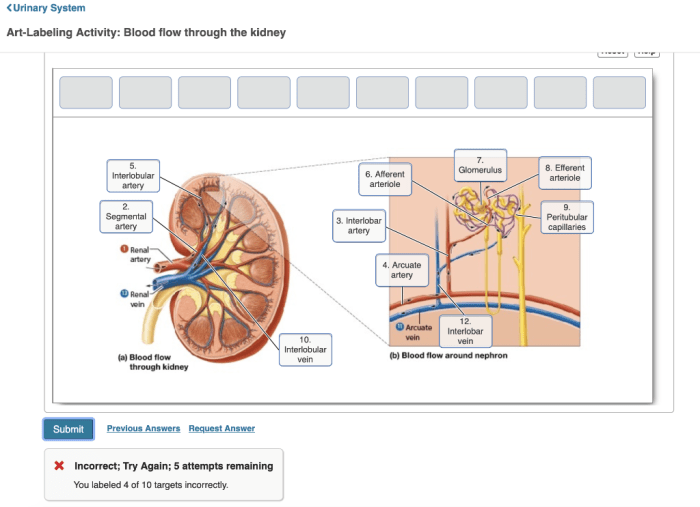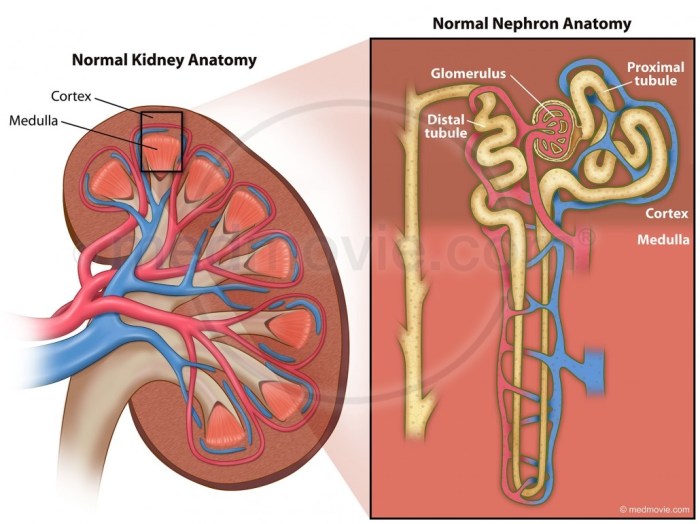Art-labeling activity internal anatomy of the kidney including the nephron – Embark on an immersive learning experience with the art-labeling activity on the internal anatomy of the kidney, including the nephron. This captivating activity not only unveils the intricate structures of this vital organ but also fosters a deeper understanding of its functions.
Delve into the kidney’s overall architecture, examining its location, shape, and size. Uncover the major structures within the kidney, guided by a detailed diagram that precisely labels each component. Discover the specific roles played by these structures in maintaining renal function.
Internal Anatomy of the Kidney: Art-labeling Activity Internal Anatomy Of The Kidney Including The Nephron

The kidneys are bean-shaped organs located on either side of the spine, just below the rib cage. They are responsible for filtering waste products from the blood and producing urine.The internal anatomy of the kidney is complex, but can be divided into two main regions: the cortex and the medulla.
The cortex is the outer layer of the kidney and contains the glomeruli, which are small clusters of blood vessels that filter waste products from the blood. The medulla is the inner layer of the kidney and contains the tubules, which are small tubes that collect the filtered waste products and transport them to the bladder.
The Nephron
The nephron is the functional unit of the kidney. Each kidney contains about 1 million nephrons. The nephron is responsible for filtering waste products from the blood and producing urine.The nephron consists of several different segments, including the glomerulus, the proximal tubule, the loop of Henle, and the distal tubule.
The glomerulus is a small cluster of blood vessels that filters waste products from the blood. The proximal tubule is a small tube that reabsorbs water and nutrients from the filtrate. The loop of Henle is a U-shaped tube that helps to concentrate the filtrate.
The distal tubule is a small tube that secretes ions and water into the filtrate.
Art-Labeling Activity, Art-labeling activity internal anatomy of the kidney including the nephron
Art-labeling activities can be a great way to help students learn about the internal anatomy of the kidney. Here is a simple art-labeling activity that you can use in your classroom:Materials:* A diagram of the internal anatomy of the kidney
- Markers or crayons
- Labels for the different structures of the kidney
Instructions:
- Give each student a diagram of the internal anatomy of the kidney.
- Ask students to label the different structures of the kidney using the markers or crayons.
- Once students have finished labeling the diagram, ask them to answer the following questions:
* What are the different structures of the kidney?
- What are the functions of the different structures of the kidney?
- How does the kidney filter waste products from the blood?
- How does the kidney produce urine?
Discussion
Art-labeling activities can be a great way to help students learn about the internal anatomy of the kidney. They are a fun and engaging way for students to learn about the different structures of the kidney and their functions.I have used art-labeling activities in my own teaching and have found them to be a very effective way to help students learn about the internal anatomy of the kidney.
Students are always very engaged in the activity and they learn a lot about the kidney.One challenge that I have encountered when using art-labeling activities is that some students can get frustrated if they are not able to label all of the structures correctly.
To help with this, I always provide students with a list of the structures that they need to label and I also allow them to use their textbooks or other resources to help them.
FAQ Guide
What is the significance of the nephron in kidney function?
The nephron is the functional unit of the kidney, responsible for filtering blood, reabsorbing essential nutrients, and eliminating waste products.
How does art-labeling enhance the learning process?
Art-labeling activities provide a hands-on, visual approach that stimulates multiple senses, improving retention and comprehension.

